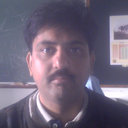
Ashwin PandeAhmedabad University · School of Arts and Sciences
Ashwin Pande
M.S.,Ph.D.( Physics), M.A,Ph.D. (Pure Mathematics)
About
12
Publications
666
Reads
How we measure 'reads'
A 'read' is counted each time someone views a publication summary (such as the title, abstract, and list of authors), clicks on a figure, or views or downloads the full-text. Learn more
205
Citations
Introduction
I work on problems in Pure Mathematics connected to
problems in Theoretical Physics. I am currently interested
in Topological T-duality, which attempts to mimic the
T-duality symmetry of Type II String Theory using techniques
from Algebraic Topology and Noncommutative Geometry.
Additional affiliations
Education
August 2000 - May 2007
September 1993 - May 2000
August 1990 - May 1993
Publications
Publications (12)
In this paper we study the topological T-dual of spaces with a non-free circle action mainly using the stack theory method of Bunke and co-workers \cite{Bunke1}. We first compare three formalisms for obtaining the Topological T-dual of a semi-free S1-space in a simple example. Then, we calculate the T-dual of general KK-monopole backgrounds using t...
Let X be the topological space associated to a finite-dimensional manifold. Further, let p : X → W be a principal circle bundle. We consider C 0 (X)-algebras D which are locally trivial C *-bundles over X with fiber A ⊗ K where A is a strongly self-absorbing C *-algebra as in Ref. [1]. We show that we may lift the S 1-action on X to a unique R-acti...
We extend the formalism of Topological T-duality to spaces which are the
total space of a principal $S^1$-bundle $p:E \to W$ with an $H$-flux in
$H^3(E,Z)$ together the together with an automorphism of the continuous-trace
algebra on $E$ determined by $H$. The automorphism is a `topological
approximation' to a gerby gauge transformation of spacetim...
We explicitly construct the $C^{\ast}-$algebras arising in the formalism of Topological T-duality due to Mathai and Rosenberg from string-theoretic data in several key examples. We construct a continuous-trace algebra with an action of ${\mathbb R}^d$ unique up to exterior equivalence from the data of a smooth ${\mathbb T}^d$-equivariant gerbe on a...
We show that Topological T-duality proposed by Mathai and Rosenberg may be used to define a T-dual for a semi-free S 1-space. In particular, we argue that it gives the physical T-dual for a system of n Kaluza-Klein (KK) monopoles. We show that the 'dyonic coordinates' well known in the physics literature may be incorporated within this formalism of...
We study topological T-duality for spaces with a semi-free $S^1-$action with isolated fixed points. Physically, these correspond to spacetimes containing Kaluza-Klein monopoles. We demonstrate that the physical dyonic coordinate of such spaces has an analogue in our formalism. By analogy with the Dirac monopole, we study these spaces as gerbes. We...
We give an overview of our studies of spiral turbulence and spatiotemporal chaos in partial-differential-equation models for two excitable media: (a) the oxidation of carbon monoxide on and (b) ventricular fibrillation in mammalian hearts. Our characterization of spiral turbulence and spatiotemporal chaos in these models leads us to an efficient sc...
Ventricular fibrillation, the major reason behind sudden cardiac death, is turbulent cardiac electrical activity in which rapid, irregular disturbances in the spatiotemporal electrical activation of the heart makes it incapable of any concerted pumping action. Methods of controlling ventricular fibrillation include electrical defibrillation as well...
We present a detailed study of the statistical steady states of a model for CO oxidation on Pt(110) proposed by Bär and co-workers. We show that the stability diagram of this model depends sensitively on the boundary conditions. We elucidate several novel properties of a state with meandering spirals (M) briefly mentioned by Bär and co-workers. (1)...
We give a brief overview of systems that show spiral patterns and spatiotemporally chaotic states. We concentrate on two physical systems: (1) the oxidation of CO on Pt(110) and (2) ventricular fibrillation in hearts. The equations that have been suggested as simple models for these two different systems are closely related for they are both {\it e...
We present numerical studies of a model for CO oxidation on the surface of Pt(110) proposed in Ref. 1. The model shows several interesting regimes, some of which exhibit spatiotemporal chaos. The time series of the CO concentration at a given point consists of a sequence of pulses. We concentrate on interpulse intervals theta and show that their di...
We review some advances in the theory of homogeneous, isotropic turbulence. Our emphasis is on the new insights that have
been gained from recent numerical studies of the three-dimensional Navier Stokes equation and simpler shell models for turbulence.
In particular, we examine the status of multiscaling corrections to Kolmogorov scaling, extended...


























